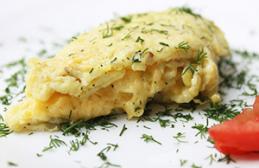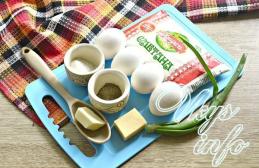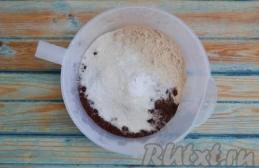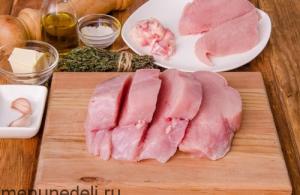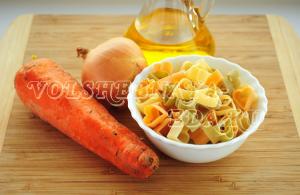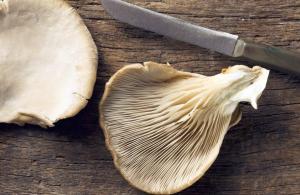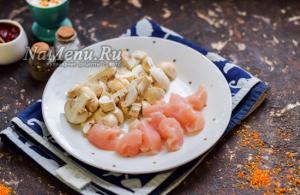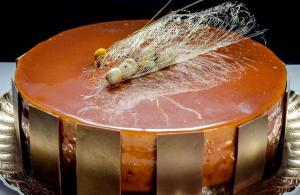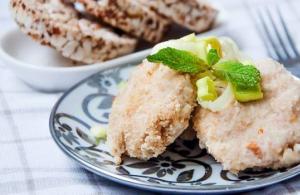Those who love fragrant and soft Easter cakes will definitely like Easter baking, the yeast dough for which is made on the basis of sour cream. Easter cakes made with sour cream are incredibly tasty and fluffy, and most importantly, if stored properly, they will not go stale for a long time.
Easter cake with sour cream and candied fruits
Notes and Tips:
Approximately from the specified amount of products you get 2 large Easter cakes, 2 medium ones and 8 small ones.
It is better to use homemade eggs for cooking. This will have a positive effect not only on the taste of Easter baked goods, but also on their color.
The indicated amount of raw yeast can be replaced with 11 grams of dry yeast.
Butter should be added to the dough softened and never melted.
Candied fruits can be replaced with light or dark seedless raisins.
sour cream cake recipe
Ingredients:
- fat sour cream – 250 grams,
- milk – 300 ml,
- butter – 150 grams,
- raw yeast – 60 grams,
- granulated sugar – 200 grams,
- fresh eggs – 3 pcs.,
- yolk – 1 pc.,
- wheat flour - about 900 grams,
- multi-colored candied fruits - about 150 grams.
Additionally, to decorate Easter cakes you will need chilled egg whites (2 pcs.), powdered sugar (1 cup), lemon juice (2 tablespoons) and confectionery powder.
Cooking process:
Heat the milk to about 35 degrees and combine with crumbled yeast and 1 teaspoon of sugar. Mix everything thoroughly and leave at room temperature for about 10 minutes. If you have taken high-quality yeast, then during this time a lush foam will appear on the surface of the milk.

Sift 200 grams of flour through a sieve and gently stir them into the milk and yeast mixture.

Cover the bowl with the dough with a towel and leave in a warm place for about 30 minutes.
While the dough is increasing in size, you can take care of the eggs, namely, beat them together with granulated sugar into a fluffy white mass.

During this time the dough will more than double in size.

Very carefully add to it one by one: beaten eggs, soft butter and sour cream at room temperature.

Sift the rest of the flour through a sieve and mix into the dough with smooth movements.

At first, you can work with a plastic spatula, but then it’s better to handle the sour cream-based yeast dough with your hands. The finished dough should not be very stiff and stick to your hands only slightly.

Transfer it to a deep container greased or sprinkled with flour, cover with a towel and leave warm for another 60 minutes. During this hour, the sour cream yeast dough for Easter cakes will grow at least 2 times.

When this happens, roll the prepared candied fruits in a small amount of flour and stir them into the dough. Leave it warm for another 30 minutes.

Prepare molds for baking Easter cakes.
Tip: if you don’t have special metal or silicone molds for Easter cakes, then you can use metal mugs, muffin tins and other more or less suitable devices instead. The only thing is that then their bottom and walls must be lined with oiled parchment paper. Moreover, the paper should be at least twice as high as the level of the molds, so that the dough, after rising, does not leak out of them.

Fill the prepared molds no more than a third full and set aside for another 30 minutes. When the dough has risen sufficiently, brush the tops of the Easter cakes with beaten yolk and place the molds with them in an oven preheated to 180 degrees. Bake the sour cream cakes in the oven for about 40 minutes (small ones take a little less time, and large ones a little more).

Check the readiness of the browned Easter cakes with a toothpick - if it remains dry after piercing the dough, then they can be removed from the oven. It’s better to cool the cakes on their side, so they definitely won’t fall off.

To decorate Easter baked goods, beat egg whites, lemon juice and powdered sugar into a stable foam. Brush slightly cooled Easter cakes with snow-white glaze and sprinkle with multi-colored confectionery powder to taste.

Store Easter cake with sour cream in a tightly closed container (for example, in a deep saucepan). Wrap in a cloth towel.
Photo recipe for Easter cake with sour cream from Svetlana Soroka
A very tasty treat that you can prepare for Easter in your kitchen is cream cake. This is ideal for baking Easter products. By adhering to the recipe and basic cooking rules, you will be able to please your family members and loved ones at the festive table.
For holiday baking, you must definitely use fresh cream with a fat content of 20% to 33%. A high-quality product has a uniform white color with a light creamy tint. But if in the glass you see small white flakes of protein or the cream completely separates, this is a clear sign that the product is spoiled.
Since the cooking process is quite lengthy, the ingredients need to be prepared in advance, so experts advise pulling the cream out of the refrigerator in the evening. If you are still afraid that they will disappear at room temperature, then you need to warm them up a little before cooking. But do not boil too much and under no circumstances, as hot cream will kill the yeast and your cake simply will not rise. Many people use store-bought cream for baking, but experienced housewives recommend using those sold on the market. They are the ones who will make your baked goods soft, fluffy and tender, with a pronounced creamy taste.
Holiday baking recipe
This product is somewhere in the middle between bread and a roll. Therefore, it is important not to go overboard so that it turns out tender, fluffy, rich and at the same time satisfying. The recipe for Easter cake with cream and yolks is very simple, but requires compliance with all cooking rules. The dough will take a long time to rise, since a lot of yolks are used for baking. Therefore, you need to knead it well in a food processor or you will have to work hard kneading it with your hands.
To prepare we will need:
- 50 g yeast (fresh);
- 750 ml heavy cream;
- 12 fresh yolks;
- 400 g butter;
- 300 g sugar;
- 1.2 kg flour;
- 50 ml vodka;
- 50 g lemon zest;
- 100 g raisins;
- 100 g almonds;
- a pinch of saffron;
- 1 nutmeg;
- oil for the mold.
It is not advisable to use proteins. Although they will make the cake more porous, the finished product will become quite hard and quickly become stale. To knead the dough, you can use a food processor, but if you don’t have one, you will have to knead by hand.
Preparing the dough
After kneading the sponge dough, cut it with a knife and place it in a bowl, which we place in a saucepan with warm water for 1 hour.


Pour vodka over the saffron and leave for half an hour. Wash and dry the raisins with a paper towel. Cut candied fruits and almonds into small pieces. Grate the nutmeg.


Beat the yolks with sugar until white, and then add the pre-melted butter and continue beating. When the dough has risen, add the yolk mixture, prepared saffron along with the infusion, the remaining warm cream, as well as raisins, candied fruits and almonds.


Mix everything well for 15 minutes. Place the dough in a bowl and cover it with a towel. Place in a warm place for 2 hours.


After the dough has risen, knead it well again and place it in silicone molds, which must be greased with butter in advance. If the molds are metal, it is better to use parchment paper moistened with butter. The dough in the molds should stand for another 1 hour in a warm place.
And then you can put it in the oven, preheated to 180 degrees. The cooking time will depend on the size of the cake itself. Therefore, insert a wooden stick into the dough, which will allow you to check the readiness of the product. The cooled cake can be greased with pre-prepared whipped egg whites and sugar and decorated with candied fruits or special store-bought powder.
The butter-free recipe uses milk or water. The main thing in this case is temperature. Like cream, milk should be warm. Despite the many recipes, the technology for preparing the holiday product is the same.
Basic cooking rules
In order for the cake to turn out excellent, an important point is not only the correct preparation of the dough, but also its baking. You can spoil it at any stage. Therefore, you should follow several basic rules for preparing Easter cakes.
- All products must be fresh and of high quality.
- The dough should rise 3 times. The dough rises first when you mix the yeast with flour and cream. Then - the dough after adding the remaining ingredients, and the last time it rises in the molds.
- Easter cake dough does not like drafts. It should be suitable in a warm place with an air temperature of 30–45 degrees.
- The consistency of the dough is also important. It will be dense, but not too tight. To check, you can cut it with a knife. If it doesn't stick to it, then you did everything right.
- To make the cakes fluffy, fill the molds 1/3 full with dough, as it will rise to the desired size during baking.
- The product must be baked in a humidified oven. To do this, place a container of water in it.
- To determine the readiness of the baked goods, you should stick a wooden stick into the dough before putting it in the oven. After a while, you can pull it out and see: if the dough does not stick to the stick, then the cake is ready.
- Baking time will depend on the weight of the product. So for an Easter cake less than 1 kg it takes half an hour, for a cake weighing 1 kg – 45 minutes, for a cake weighing 1.5 kg – 60 minutes, for a cake weighing 2 kg – 1.5 hours.
- The cake should be removed from the mold only after it has cooled slightly.
- After removing the baked goods from the mold, the cake should be wrapped in a towel so that the product becomes stronger and does not fall off.
For taste and aromatic aroma, raisins, lemon zest, vanilla, cinnamon, almonds, candied fruits, cardamom, saffron or other additives are added to the dough. They can be replaced, but you cannot put anything in the dough. In order to prepare tender and fluffy Easter cakes, you need to have experience and great dexterity. They may not turn out right the first time, so you really need to follow all the baking rules.
While preparing the Easter product, it is important to be in a good mood. After all, mood plays a big role in obtaining high-quality baked goods. And what could be better than a homemade holiday cake. Its aroma will bring all family members together at the table, and its excellent taste will allow you to celebrate such a great day as Easter with pleasure.
Today we will bake with you very tender and fragrant Easter cakes with cream. The recipe will be step by step with photos (as always), so baking a delicious Easter treat will not be difficult. My blog already has recipes for this traditional pastry that I shared last year: this, and. You can follow the links and see photos and descriptions of the processes. All recipes are successful, time-tested and generations-tested!

Recipe for delicious Easter cake with heavy cream:
For the dough:
- Wheat flour - 170 gr.
- Warm cream - 240 ml. (fat content of cream from 20% and above)
- Fresh yeast - 30 grams (can be replaced with 11 grams of dry yeast, this is a small standard bag)
- Sugar - 2 teaspoons

For the test:
- Prepared dough
- Chicken eggs - 4 pcs + 1 yolk (save the white of one egg for Easter glaze)
- Sugar - 220 grams
- Salt - a pinch
- Butter at room temperature - 100 grams
- Flour - 550 grams
- Candied fruits/dried fruits/nuts – 150 grams

For Easter icing:
- White of one egg - 1 pc.
- Powdered sugar - 100 grams
- Lemon juice - a few drops
How to cook:
First we need to heat the cream (240 ml) until warm, not hot! In hot cream, the yeast will die, and the cake idea will be doomed to failure. Add yeast to the cream.
The yeast needs to be broken into small pieces before adding to the cream, at the same time check its quality: it should not be sticky and slippery, it should break well, and have a pleasant smell. If you decide to use dry yeast, do the same: place the contents of the packet (11 g) in warm cream and stir. 
Stir the cream, sugar and yeast until smooth and pour this liquid into the sifted flour (170 g). 
The result is a thick, viscous dough.
Cover it with a cotton towel and leave it in a warm, draft-free place. If the kitchen is very warm at the moment, you can leave a bowl of dough right on the table. 
The dough should double in size. This will take 20-30 minutes. The rising time of the dough directly depends on the quality of the yeast and the temperature in the room. 
Next, in a bowl, mix 4 eggs completely and one yolk, a pinch of salt, sugar and beat until fluffy. We keep the white of one egg for Easter icing. 
The egg-sugar mixture should lighten.

Add the appropriate dough to the beaten eggs. 
Now we will add flour, not all at once, but in parts. We will need approximately 550 gr. flour.

You may need a little more or a little less (depending on the size of the eggs used and the quality of the flour). Flour should be added in parts so as not to clog the dough: if this happens, the cakes will be dense and tasteless.
When all the flour is mixed into the dough, add room temperature butter. The butter should be softened (to achieve this, leave it on the table or heat it a little in the microwave).

Finally, add the remaining flour and knead the dough for 30 minutes. This can be done by hand, in a bread machine, or using a stand mixer. Do it in your usual way!

The finished dough should easily come away from the sides of the bowl. The dough turns out soft, elastic, but at the same time does not stick to your hands.
Cover the bowl with the dough with cling film (or cover with a towel) and leave in a warm, draft-free place for about 1.5-2 hours. The dough should increase in volume at least 2 times.

Look at the photo to see how well the dough came together: it is very fluffy and tender. We knead the dough, and at this stage you can optionally add 150 grams of candied fruits, nuts, and raisins. You can use zest from citrus fruits (lemon, lime, orange). This time I decided not to add anything, but to bake a delicious creamy cake so that other ingredients would not interrupt the taste of the cake itself.

After the yeast dough has been kneaded well, cover it again and let it rise a second time. Now it will take much less time to rise the dough than the first time; in about 20-30 minutes it will increase 2-3 times.

Let's start forming the cakes. For baking, it is convenient to use special paper or metal cake pans. Metal ones need to be greased with butter and sprinkled with flour; paper forms do not need to be greased.

Fill the baking pans 1/3 full. To do this, break off a small piece from the total volume of dough, form it into a ball and place it in the molds with the pinch down. Cover the formed cakes with a towel and leave them in a warm, draft-free place to prove.

After proofing, the Easter cake dough should fill the molds 2/3 full.

Place the Easter cakes in an oven preheated to 180 C. Small cakes will bake for 30-40 minutes, large ones for 50-60 minutes. Baking time directly depends on the characteristics of your oven.

You can check the readiness of the Easter cakes with a wooden stick: inserted into the middle of the Easter cake, it should come out completely dry.
These are the beautiful, tall and ruddy Easter cakes I got. Easter cakes that were baked in paper forms do not need to be removed from them. And remove the cake from the metal one 5-10 minutes after leaving the oven.

While the cakes are cooling, you can prepare the egg white glaze. To do this, add one protein and a few drops of lemon juice to 100 grams of powdered sugar.

Beat all ingredients with a mixer until fluffy and smooth.

The finished glaze for Easter cakes hardens very quickly, so it is better to use it immediately for its intended purpose, and store the leftovers in an airtight container (or cover the bowl with the glaze with a slightly damp towel so that it does not dry out).
So, as a result of whipping, we should get an elastic, beautiful glaze. You can apply the protein glaze to the cakes while they are still hot. You can dip each top into the white glaze, or apply it with a spoon.
It was convenient for me to dip the small ones into a bowl.

I poured the top of a large cake with a spoon.
The dough for the butter cake turns out porous, tender and very fragrant! Look at the cross-section of the Easter cake crumb (pictured):

Be sure to try baking Easter cakes using this recipe, I’m sure you’ll like the result!
More recently, new Easter cake recipes have appeared on the site, I recommend checking them out:
,
Share photos of the cakes you made in the comments! I will be very pleased to see your result. I wonder if it was convenient for you to work with the dough, what additives (raisins, nuts or something else) you added to the dough?! I look forward to your responses!
Kulich with sour cream is a variant of baked goods that people like to eat not only on the occasion of the Easter holidays, but also to diversify the daily menu. It enjoys the well-deserved love of many housewives due to its amazing taste and always successful results.
Easter cake with sour cream - the most delicious recipe

Fragrant homemade baked goods have a wonderful rich taste that will not leave anyone in the household indifferent. The key to a successfully prepared dish is sour cream. You definitely need to check that it doesn’t turn out too steep and doesn’t stick to your hands. Raisins will add additional piquancy to the dish.
Ingredients:
- milk – 300 ml;
- yeast – 10 g;
- flour – 700 g;
- egg – 3 pcs.;
- butter – 150 g;
- sour cream – 250 g;
- vanilla sugar – 2 tsp.
Preparation
- In a separate container, beat the eggs with sugar and pour into the mixture. Add sour cream and butter.
- Keep warm again for 30 minutes.
- Place in baking containers, filling them 1/3 full. Place in a warm place for half an hour.
- Bake for 30 minutes.

Every housewife wants to prepare delicious baked goods without spending a lot of effort. Easter cake with sour cream without yeast is such a recipe, characterized by incredible simplicity and minimal time investment. The absence of such a component as yeast will in no way affect the taste and aroma of baked goods, so everyone in the household will have the opportunity to enjoy this amazing dish.
Ingredients:
- flour – 400 g;
- butter – 50 g;
- milk – 300 ml;
- eggs – 2 pcs.;
- powdered sugar – 100 g;
- lemon juice – 4 tbsp. l.;
- soda – 1 tsp.
Preparation
- Beat the mixture of yolks and powder.
- Add oil, lemon juice.
- Pour in the heated milk. Add flour.
- Quickly pour in the whipped whites.
- Mix everything and pour into containers.
- Place the Easter cake with sour cream in the oven for an hour.

There is a cooking option that will allow you to get a real culinary masterpiece - this is Easter cake made with milk and sour cream. Recipes indicate a certain amount of flour, but it is worth considering the fact that you may need a little less or, conversely, more. Taking into account all the subtleties of cooking, you can get delicious, aromatic pastries.
Ingredients:
- milk – 0.5 l;
- sour cream – 250 g;
- butter – 100 g;
- eggs – 10 pcs.;
- sugar – 3.5 cups;
- yeast – 120 g;
- flour - 13 cups.
Preparation
- Mix eggs with sugar.
- Sprinkle yeast with sugar (1.5 cups). Add heated milk, sour cream and butter to them.
- Gradually add flour.
- Keep warm for 2 hours.
- Make a batch and leave for another 1.5 hours.
- Place in a container. Bake a delicious cake with sour cream for about an hour.

There are many holiday recipes, and every housewife can choose the most suitable one. One of the most common options for holiday baking is sour cream. To give the dish a piquant taste, you can add dried fruits at the final stage. Ready-made Easter cakes can be decorated with special sprinkles.
Ingredients:
- yolks – 20 pcs.;
- butter – 400 g;
- margarine and vegetable oil – 100 g each;
- sour cream – 200 g;
- live yeast – 150 g;
- sugar – 800 g;
- milk – 1 l;
- flour - 12 cups.
Preparation
- Make a mixture of heated milk, yeast, sand and flour.
- Place in a warm place for 2 hours.
- Pour in the yolks, butter, margarine and vegetable oil.
- Add sour cream, a little soda and salt.
- Add flour and place in a warm place.
- Place the sour cream cake in a container and bake for 20 minutes.

There is a baking option that has a special airy consistency - sour cream cake, the recipe for which is not particularly complicated. It will delight the hostess not only with its golden brown crust, but also with its magnificent rich taste, which is achieved with the help of such a component as cream. They will add tenderness and piquancy to the dish.
Ingredients:
- cream – 300 ml;
- yolks – 3 pcs.;
- butter – 100 g;
- dry yeast – 3 tsp;
- sour cream – 3 tbsp. l;
- sugar – 1 glass;
- vegetable oil – 3 tbsp. l.;
- flour – 700 g.
Preparation
- Dissolve dry yeast and a couple of tablespoons of sugar in heated water.
- Add cream, add half a glass of sugar. Keep warm for 40 minutes.
- When the dough starts to foam, add the remaining ingredients and stir.
- Keep warm for 2 hours.
- Bake the cake with sour cream in the pan for 40 minutes.

For those who prefer to eat dishes characterized not only by their taste, but also by their usefulness, sour cream is the best choice. This recipe is especially popular in families with small children, since the baked goods contain calcium due to the presence of cottage cheese. Easter cakes can be decorated with colorful sprinkles.
Ingredients:
- cottage cheese – 400 g;
- sour cream – 200 g;
- eggs – 3 pcs.;
- sugar – 200 g;
- soda – 1 tsp;
- butter – 100 g;
- flour - 2.5 cups.
Preparation
- Make a mixture of sugar, cottage cheese and sour cream. Beat eggs and butter separately.
- Mix cottage cheese and eggs. Suppress the baking soda and add to the dough.
- Add flour, knead.
- Add raisins.
- Place the cake with rich sour cream in the pan and bake for 50 minutes.
Kulich with sour cream and cognac - recipe

There are many recipes for delicious Easter cakes, and every housewife has the right to add a special twist to her recipe. Some recipes even contain alcoholic drinks. One of these cooking methods is Easter cake made with sour cream and cognac. Such an unusual approach as adding cognac will give the baked goods a special lightness and fluffiness.
Ingredients:
- milk – 300 ml;
- yeast – 10 g;
- flour – 700 g;
- egg – 3 pcs.;
- butter – 150 g;
- sour cream – 250 g;
- cognac – 1 tbsp. l.
Preparation
- Heat the milk, add yeast and flour. Place in a warm place for half an hour.
- Make the egg-sugar mixture. Add sour cream and butter, cognac.
- Keep warm for 30 minutes.
- Place in containers and leave for half an hour.
- Place the cake with rich sour cream in the oven for 30 minutes.

You can get baked goods that are characterized by a unique taste if you use the Easter cake recipe with sour cream and live yeast. A special feature of the preparation is that the base must be extremely soft, and sticking to your hands should be avoided. The dough should be extremely soft and airy, so do not overdo it with flour, it will “clog” the dough.
Ingredients:
- yolks – 20 pcs.;
- butter – 400 g;
- margarine and vegetable oil – 100 g each;
- sour cream – 200 g;
- live yeast – 150 g;
- sugar – 800 g;
- milk – 1 l;
- flour - 12 cups.
Preparation
- Add yeast, sugar and flour to heated milk. Keep warm for 2 hours.
- Gradually add all products, stirring.
- Place in containers and bake for 20 minutes.

To make the cooking process easier for the housewife, you can use certain household appliances, for example, you can make Easter cake with sour cream in a bread maker. This will help to significantly reduce cooking time; much less effort will be required. To add additional flavor using raisins or dried fruits, you need to wait until the device kneads the dough.
Ingredients:
- flour – 400 g,
- yeast 150 g,
- eggs – 2 pcs.,
- sour cream – 200 g;
- butter – 150 g;
- milk – 300 ml;
- sugar – 300 g.
Preparation
- Place liquid ingredients in a bowl and add dry ingredients. There should be flour on top, and yeast on it.
- Set the “Dough” mode for 1.5 hours, then “Baking” for 1 hour.

Another simple way is to cook. This household appliance is able to perfectly cope with its function, the baked goods will turn out porous, they rise perfectly thanks to the uniform distribution of temperature and heat inside the bowl. In addition, the cakes retain their shape and do not settle after they have cooled.
Ingredients:
For the dough:
- flour - 170 grams;
- cream 33% - 240 milliliters (take fat content above 20%);
- fresh pressed yeast - 30 grams (or 11 grams of dry);
- sugar - 1 level tablespoon.
For the test:
- flour - 550 grams;
- butter - 100 grams;
- sugar - 220 grams;
- eggs - 4 pieces plus one yolk;
- salt - a pinch;
- nuts, raisins, candied fruits, dried fruits - 150 grams.
For the glaze:
- protein - 1 piece;
- powdered sugar - 100 grams;
- lemon juice.
Decorate to your taste with confectionery sugar sprinkles or simply leave it in the glaze.
Easter cake with cream. Step by step recipe
Let's start preparing the dough.
- Take the cream and heat it to 35-40*C: it should be warm, but not hot.
- Add two teaspoons of sugar and yeast to the cream (break into small pieces). Let's dissolve it all.
- Sift the flour thoroughly. Pour the mixture into the flour and stir until smooth. Cover with a towel and place in a warm place: for approximately 25-30 minutes - everything will depend on the temperature and quality of the yeast. The dough should rise approximately 2 times.
- In the next step, we beat four eggs and one yolk with a pinch of salt and sugar. A mixer works better here than a whisk. You need to beat until fluffy foam. We put one protein in the refrigerator: it will be needed for the glaze.
- Add our dough to the beaten eggs. Mix carefully. And add the sifted flour in parts.
You may need less or more flour: it all depends on the flour itself and the size of the eggs.
- When almost all the flour has been added, it's time for the butter: it should be at room temperature.
If you forgot to take it out in advance and you have it from the refrigerator, then put it in the microwave for a couple of seconds (bring it to a soft state).
- Add the remaining flour and continue kneading the dough.
It takes a long time to knead the dough for Easter cake. At least 30 minutes.
- Today there are many different tools and techniques for kneading dough. You can use a bread machine, food processor, special dough mixer, or knead by hand. I prefer to do it myself: for this holiday I want to make Easter cake with my own hands, to convey my bright mood through the warmth of my hands.
- The finished dough should come away from the walls of the bowl or bowl in which you kneaded it, should not stick to your hands, and should be soft and elastic. Cover the bowl with the dough with cling film and place in a warm place for two hours. During this time, the dough should increase in volume: at least twice.
- After a couple of hours we return to the test. It fits and looks very lush. We knead it and, if desired, we can add 150 grams of nuts, dried fruits, candied fruits and citrus zest.
- Now let's start choosing forms for baking Easter cake in the oven. Every year they become more diverse and accessible. Personally, I prefer paper forms of different sizes. There is no need to lubricate them with oil. If you bake in iron pans, be sure to grease them with oil.
- Let's move on to forming the dough into balls. We tear off a piece, pinch it and place the smooth side on top. The form should be approximately ⅓ full. After this, cover all the molds with a towel. Give the dough time to rise and fill the form 3/4 full.
- While the dough is rising, preheat the oven to 180*C.
- Bake small molds for approximately 30-40 minutes, large ones for approximately 50-60 minutes.
- Place our homemade cakes in a preheated oven.
- Now, while the cakes are in the oven, it's time to make the icing. Add the chilled protein and a few drops of lemon juice to the powdered sugar. Beat everything with a mixer until fluffy. After the glaze is ready, cover it so that it does not dry out.
- Check the readiness of the Easter cakes with a wooden stick. We pierce the cake from top to bottom: the stick must be completely dry. After that, brush with glaze. You don’t have to wait for the cakes to cool down: you can grease them while they’re hot. I like to dip it cap side down into the bowl of icing to ensure even coloring.
- Now the best part: decorating our Easter cakes. Confectionery powders, mastic figures, dried fruits and various kinds of sweet decorations are suitable for this process.
This exciting process is over. The most wonderful thing is that we did everything ourselves - and this is always highly appreciated and gives us an incredibly festive mood. On the “I Love to Cook” website there are many more wonderful recipes for Easter cakes in the oven: choose and cook with us - we only have delicious and proven recipes.

